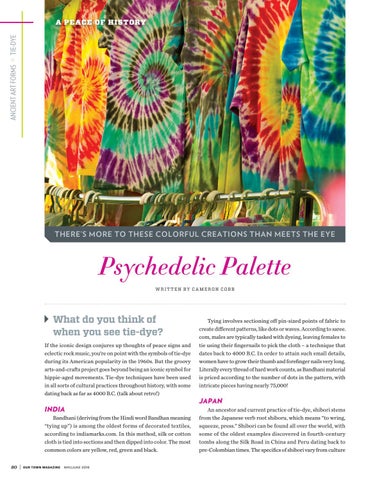80
ANCIENT ART FORMS >> TIE-DYE
A PEACE OF HISTORY
THERE’S MORE TO THESE COLORFUL CREATIONS THAN MEETS THE EYE
Psychedelic Palette W R ITTEN BY CA MERON COBB
What do you think of when you see tie-dye? If the iconic design conjures up thoughts of peace signs and eclectic rock music, you’re on point with the symbols of tie-dye during its American popularity in the 1960s. But the groovy arts-and-crafts project goes beyond being an iconic symbol for hippie-aged movements. Tie-dye techniques have been used in all sorts of cultural practices throughout history, with some dating back as far as 4000 B.C. (talk about retro!)
Tying involves sectioning off pin-sized points of fabric to create different patterns, like dots or waves. According to saree. com, males are typically tasked with dyeing, leaving females to tie using their fingernails to pick the cloth – a technique that dates back to 4000 B.C. In order to attain such small details, women have to grow their thumb and forefinger nails very long. Literally every thread of hard work counts, as Bandhani material is priced according to the number of dots in the pattern, with intricate pieces having nearly 75,000!
JAPAN INDIA Bandhani (deriving from the Hindi word Bandhan meaning “tying up”) is among the oldest forms of decorated textiles, according to indiamarks.com. In this method, silk or cotton cloth is tied into sections and then dipped into color. The most common colors are yellow, red, green and black. 80 |
OUR TOWN MAGAZINE
MAY/JUNE 2018
An ancestor and current practice of tie-dye, shibori stems from the Japanese verb root shiboru, which means “to wring, squeeze, press.” Shibori can be found all over the world, with some of the oldest examples discovered in fourth-century tombs along the Silk Road in China and Peru dating back to pre-Colombian times. The specifics of shibori vary from culture
